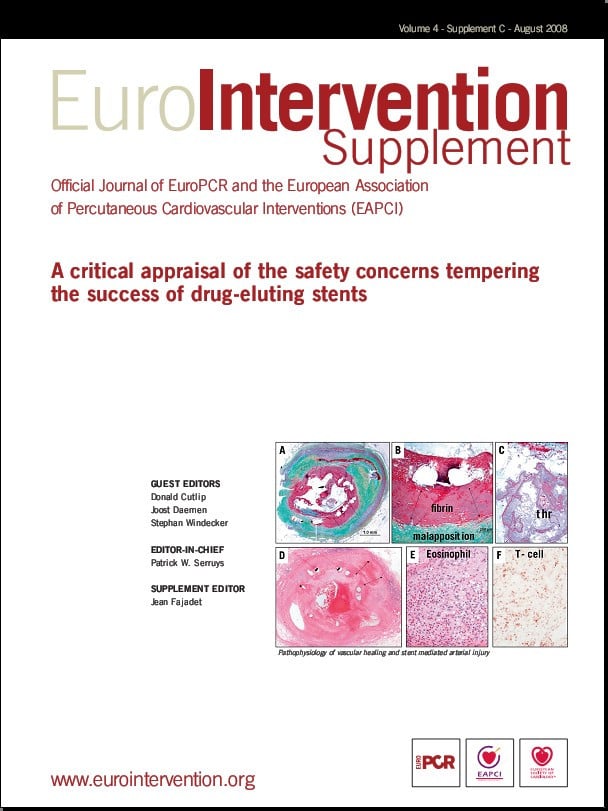Abstract from the ESTROFA registry
Abstract
Objectives: This study sought to assess the incidence, predictors, and outcome of drug-eluting stent (DES) thrombosis in real-world clinical practice.
Background: The DES thromboses in randomized trials could not be comparable to those observed in clinical practice, frequently including off-label indications.
Methods: We designed a large-scale, nonindustry-linked multicentered registry, with 20 centers in Spain. The participant centers provided follow-up data for their patients treated with DES, reporting a detailed standardized form in the event of any angiography-documented DES-associated thrombosis occurring.
Results: Of 23,500 patients treated with DES, definite stent thrombosis (ST) developed in 301: 24 acute, 125 subacute, and 152 late. Of the late, 62 occurred >1 year (very late ST). The cumulative incidence was 2% at 3 years. Antiplatelet treatment had been discontinued in 95 cases (31.6%). No differences in incidences were found among stent types. Independent predictors for subacute ST analyzed in a subgroup of 14,120 cases were diabetes, renal failure, acute coronary syndrome, ST-segment elevation myocardial infarction, stent length, and left anterior descending artery stenting, and for late ST were ST-segment elevation myocardial infarction, stenting in left anterior descending artery, and stent length. Mortality at 1-year follow-up was 16% and ST recurrence 4.6%. Older age, left ventricular ejection fraction <45%, nonrestoration of Thrombolysis In Myocardial Infarction flow grade 3, and additional stenting were independent predictors for mortality.
Conclusions: The cumulative incidence of ST after DES implantation was 2% at 3 years. No differences were found among stent types. Patient profiles differed between early and late ST. Short-term prognosis is poor, especially when restoration of normal flow fails. (J Am Coll Cardiol 2008;51:986-90) © 2008 by the American College of Cardiology Foundation.
Acknowledgement
Reprinted from the Journal of the American College of Cardiology Volume 51, Issue 10, 11 March 2008, Page 986 with permission from Elsevier.
Commentary on the ESTROFA registry
The price of finally solving the restenosis issue could not have been that high. Following “black” September 2006, drug-eluting stents (DES) appeared notoriously in the media. From that moment on, many attempts have been made by the institutions working together with physicians to actually define the nature, the incidence, the predictors and the outcomes of DES thrombosis. In order to clean up all the available data, standardised definitions of thrombosis were applied in all trials and re-analyses and meta-analyses from individual data collected in randomised trials was performed. The main messages raised from these analyses may be synthesized in two parts: yes, there is a slight increase in very late stent thrombosis through the use of DES, but no, this is not to the detriment of any increase in hard endpoints such as cardiac mortality.
While this may be true for randomised trials, doubts could persist in the so-called off-label indications. In line with this, data presented in ESC 2007 regarding mortality in ST-segment elevation myocardial infarction and DES implantation from the GRACE Registry could reinforce this idea of the deleterious effects of these stents.
For these reasons, data coming from multicentre, large-scale or nationwide and non-industry-linked registries are most welcome. The excellence of these registries is the absence of exclusion criteria reflecting the applicability and generalisation of the results in real world practice. Fitting within these parameters resides the ESTROFA Registry. More than 23,500 patients were included in 20 centres throughout Spain. The incidence of definitive stent thrombosis at three years could be defined: 2%. Importantly, the incidence of very late stent thrombosis (more specific of DES) almost mimics that of randomised controlled trials and other registries (0.4% from the first to second-year follow-up and 0.4% from the second to the third-year follow-up). Of note, ST-segment elevation myocardial infarction appeared to be the most potent independent predictor of thrombosis both in the acute/subacute phase and in the late phase. A recent meta-analysis of all randomised trials with DES in acute myocardial infarction showed a beneficial effect in terms of major adverse cardiac events as compared to bare metal stent implantation without any increase in stent thrombosis at one year follow-up1. However, it is important to highlight the restricted inclusion/exclusion criteria of a vast majority of randomised trials in acute myocardial infarction and the short-term (one year) follow-up reported in the above-mentioned meta-analysis. Data from the ESTROFA registry thus suggests a word of caution when generalising the indication of DES in the population of acute myocardial infarction. New dedicated trials in this clinical situation, with the use of the second generation of DES are warranted. In this regard, the upcoming multicentre, randomised, EXAMINATION (Evaluation of Xience-V stent in Acute Myocardial INfArctTION) trial will include 1,500 patients with acute myocardial infarction (<24 hours) with a broad inclusion criteria (primary angioplasty, rescue angioplasty, cardiogenic shock, latecomers [>12-24hours], after successful thrombolysis). The primary endpoint will be major adverse cardiac events (ARC definition) at one year follow-up, although long-term follow-up is scheduled for five years. Results of this trial will certainly shed light on the true behaviour of DES in the acute, subacute, late and very late phase of this thrombogenic state.
Reference

